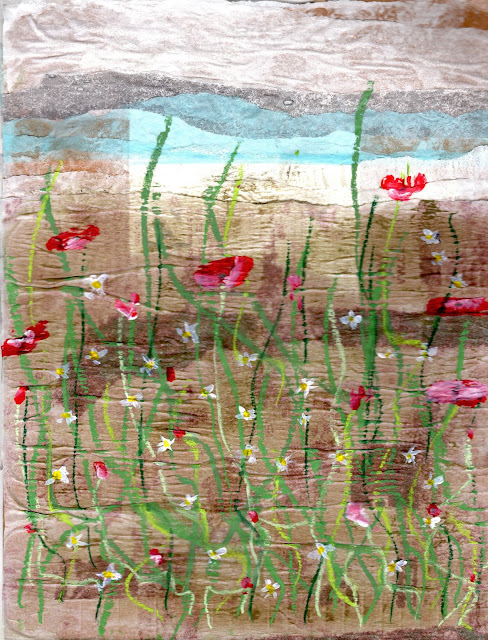I'm a regular visitor to the Yorkshire Sculpture Park because their exhibitions are second to none. Henry Moore was the founding patron and was influential in making it the great place it is today. I went specifically to see the drawings of Henry Moore but there was also a large exhibition of the work of Sir Anthony Caro.
I'd not known of Moore's skill as a artist until my tutor drew my attention to the Shelter drawings done during the war. I was keen to see more.
The exhibition is called "Back to Land" and demonstrates the effect a Yorkshire upbringing had on Moore's life.
The land of Moore's Yorkshire childhood was one of revealing contrasts: the industrial, smog laden town of Castleford and the clean air and dramatic beauty of the surrounding countryside .... (1)
As usual the exhibition was well curated and my focus was on the drawings. I immediately picked out some that I could learn a lot from and the main ones were the Stonehenge drawings from 1973.
 |
| Stonehenge A - Henry Moore. 1973. |
 |
| Stonehenge B - Henry Moore. 1973. |
 |
| Stonehenge B - Henry Moore. 1973. |
These images impressed me because they take my understanding of mark making to an entirely new level . Moore manages to get shape, form, perspective and tone with (apparently) very simple lines.
Moore himself seemed quite overwhelmed by Stonehenge and appreciated it for its current presentation rather than historical significance.
I began the Stonehenge series with etching in mind, but as I looked at, and drew, and thought about Stonehenge, I found that what interested me most was not its history, nor its original purpose – whether chronological or religious – or even its architectural arrangement, but its present-day appearance. I was above all excited by the monumental power and stoniness of the massive man-worked blocks and by the effect of time on them. Some 4000 years of weathering has produced an extraordinary variety of interesting textures; but to express these with an etching needle was very laborious, and after making two or three etchings I changed to lithography which I found more in sympathy with the subject – lithography, after all, is drawing on stone. (2)
The work itself is quite small but there is a feeling of Moore's experience of "monumental power" about them.
There was also some of Moore's Shelter Drawings in the exhibition. One of the reasons Study for Grey Tube Shelter (1940) was interesting to me was the use of wax as a resist. Many of the important parts of the work like heads and limbs are drawn using wax.
 |
| Study for "Grey Tube Shelter - Henry Moore 1940 (1) |
Another image that impressed me was "Women Winding Wool" because of its very human subject and personal feel. It's amazing that Moore could work on the huge scale of his sculptures and such a small scale on his drawings and retain sensitivity in both.
 |
| Women Winding Wool - Henry Moore 1948 (1) |
In the exhibition this work was accompanied by a poem by Simon Armitage which details the everyday life of women like those in the drawing. Very powerful.
This is a wonderful exhibition and I feel lucky to have been bought the catalogue as a long lasting resource.
(1) YSP (2015) Henry Moore Back to Land, p13















































